– Is the study of how the government or public sector pays for or finance expenditures through taxes and borrowing .Public finance adapts and applies the fundamental microeconomic theory of markets to the public sectors and government sectors.In particular,this area of study analyses the efficiency of taxes and the market failure of public goods.Public finance is also a key to the study of government stabilization polices that address the inflation and unemployment problems of business cycle.
THE FOLLOWING ARE THE FUNCTIONS OF THE GOVERNMENT.
- The government makes sure it maintains peace and harmony by providing security among their people. The government does it through employing policemen, armed forces, magistrate etc.
-
Administrative function,
The government is responsible for the day to day running of activities in the economy, i.e. the government sets different departments and sectors to enable it administer their activities in its economy.
-
Social function.
The government provides social needs such as education, health, housing etc.
-
Development function.
The government provides funds for projects like roads construction, rural electrification, irrigation etc.
DIVISION OF PUBLIC FINANCE.
Public finance is divided into four areas including
- Public revenue
- Public expenditure
- Government budget
- Public borrowing / debt
edu.uptymez.com
GOVERNMENT REVENUE.
Refers to the amount of money which received by the government from different sources.
The following are source of government revenue;
i) Tax: is a compulsory payment levied by the government on individuals or companies to meet the expenditure which is required for public welfare.
ii) Fees: Are all payment made to the government on any direct services rendered/provided. E.g. payment of road licenses, stamp duty.
iii) Fines: Are penalties imposed by the government to the low breakers.
iv) State property:(Also known as public property)is a property that is owned by all, but is is accessed and use is controlled by the state.An example is a National Park or National Stadium.
v) Selling of public good: Like government shares,Through privatization of public companies like Tanesco in 2005,National Micro-finance Bank (NMB) in Tanzania hence the amount of money earned is revenue.
vi) Profit obtains from government properties like bus stations and public buses like UDA,uses of roads
and airports etc.
vii) Special assessment: It is amount of money charged to people living in an area for specific purpose.
viii) Internal loan from central Bank for different uses like government projects.
ix) External loan from International financial Institution WORLD BANK, IMF and Development bank.
x) Grant and gifts inform of cash.
xi) Foreign Investment
xii) Gambling.
TAXATION.
is the imposition or infliction of taxes.The process whereby charges are imposed on individuals/property by legislative branch of the state or federal government to raise funds for public purposes.
The following principles or cannons are important for good tax system when tax is imposed it must fulfill the following conditions.
CANONS OF TAXATION (PRINCIPLE)
According to Adam smith there are four important canons of taxation which are( canons of equity,certainty,convenience and economy)and other additions like canon of productivity,elasticity,flexibility,simplicity and diversity as discussed below.
1. Canon of Equity.
he principle aims at providing economic and social justice to the people. According to this principle, every person should pay to the government depending upon his ability to pay. The rich class people should pay higher taxes to the government, because without the protection of the government authorities (Police, Defence, etc.) they could not have earned and enjoyed their income. Adam Smith argued that the taxes should be proportional to income, i.e., citizens should pay the taxes in proportion to the revenue which they respectively enjoy under the protection of the state.
2. Canon of Certainty
According to Adam Smith, the tax which an individual has to pay should be certain, not arbitrary. The tax payer should know in advance how much tax he has to pay, at what time he has to pay the tax, and in what form the tax is to be paid to the government. In other words, every tax should satisfy the canon of certainty. At the same time a good tax system also ensures that the government is also certain about the amount that will be collected by way of tax.
3. Canon of Convenience
The mode and timing of tax payment should be as far as possible, convenient to the tax payers. For example, land revenue is collected at time of harvest income tax is deducted at source. Convenient tax system will ennglish-swahili/courage” target=”_blank”>courage people to pay tax and will increase tax revenue.
4. Canon of Economy
This principle states that there should be economy in tax administration. The cost of tax collection should be lower than the amount of tax collected. It may not serve any purpose, if the taxes imposed are widespread but are difficult to administer. Therefore, it would make no sense to impose certain taxes, if it is difficult to administer.
Additional Canons of Taxation
Activities and functions of the government have increased significantly since Adam Smith’s time. Government are expected to maintain economic stability, full employment, reduce income inequality & promote growth and development. Tax system should be such that it meets the requirements of growing state activities.
Accordingly, modern economists gave following additional canons of taxation.
5. Canon of Productivity
It is also known as the canon of fiscal adequacy. According to this principle, the tax system should be able to yield enough revenue for the treasury and the government should have no need to resort to deficit financing. This is a good principle to follow in a developing economy.
6. Canon of Elasticity
According to this canon, every tax imposed by the government should be elastic in nature. In other words, the income from tax should be capable of increasing or decreasing according to the requirement of the country. For example, if the government needs more income at time of crisis, the tax should be capable of yielding more income through increase in its rate.
7. Canon of Flexibility
It should be easily possible for the authorities to revise the tax structure both with respect to its coverage and rates, to suit the changing requirements of the economy. With changing time and conditions the tax system needs to be changed without much difficulty. The tax system must be flexible and not rigid.
8. Canon of Simplicity
The tax system should not be complicated. That makes it difficult to understand and administer and results in problems of interpretation and disputes. In India, the efforts of the government in recent years have been to make the system simple.
9. Canon of Diversity
This principle states that the government should collect taxes from different sources rather than concentrating on a single source of tax. It is not advisable for the government to depend upon a single source of tax, it may result in inequity to the certain section of the society; uncertainty for the government to raise funds. If the tax revenue comes from diversified source, then any reduction in tax revenue on account of any one cause is bound to be small.
-
SYSTEMS OF TAXATION.
There are mainly three tax systems.
edu.uptymez.com
-
Progressive tax systems.
This is a tax system in which the tax rate increase with increase in income. It is aimed at reducing the gap between the rich and the poor (income gap) or income inequality.
Example of progressive tax is direct tax from income which is PAYE (Pay As You Earn).
It can be illustrated as follows.

-
Proportional tax system.eg changes in income.
This is a tax system in which the tax rate is constant or fixed regardless of the changes in income. Aim to collect more money.Proportional taxes maintain equal tax incidence regardless of the ability-to-pay and do not shift the incidence disproportionately to those with a higher or low economic well-being
Graphical illustration.
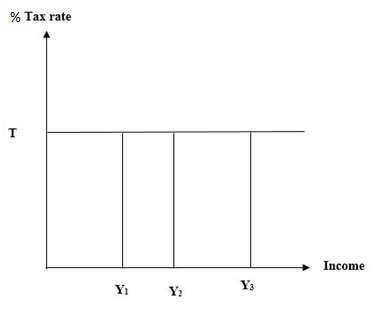
-
Regressive tax system.
A tax system where the tax rate decreases with increase in income (The higher the income,the low the proportional of the income is payed as tax and the low the income, the higher the proportional of the income is payed as tax. It is mainly used to ennglish-swahili/courage” target=”_blank”>courage investments.Example Social security tax ,for 2007 in USA,you pay 6.2% tax on wages up to a maximumu wage of$97,500.Therefore
(i) A person who makes $30,000 a year pays $1,860 (30,000 x 0.062) in tax or 6.2% of wages
edu.uptymez.com
(ii)A person who makes $200,000 a year pays $6,045 (97,500 x 0.062) in tax or 3% of wages.
(iii) A person who makes $500,000 a year pays $6,045 (97,500 x 0.062) in tax or 1.2% of wages.
Since the richest people pay the smallest percentage of their in tax,it is a regressive tax.
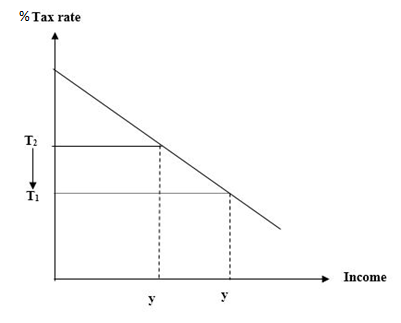
Requirement of a Good Tax Structure / System
The tax structure is a part of economic organization of a society and therefore fit in its overall economic environment. No tax system that does not satisfy these basic condition can be termed a good one.
However, the state should pursue mainly following principles in structuring its tax system :-
1.The primary aim of the tax should be to raise revenue for public services.
2.People should be asked to pay taxes according to their ability to pay and assessment of their taxable capacity should be made primarily on the basis of income and property.
3.Tax should not be discriminatory in any aspect between individuals and also between various groups.
4.Tax system should be flexible and tax law should be clear and simple.
5.They should be comprehensive,it covers a wide tax base
6.They should be economical,should reduce the cost of tax administration
7.It should avoid double taxation.
TYPES OF TAX
1: DIRECT TAX.
Taxes which are imposed on incomes and personal property and whose burden is not shifted to another.
The direct tax includes (a) Pay as you earn(PAYE) (b) corporation tax (c) Capital gain tax (d) Agriculture revenue tax (e) Death/estate duty. (f) Property tax (g) Inheritance duty (h) Surtax. is the tax imposed on very rich person who earn much money.
ADVANTAGES OF DIRECT TAX.
- It is economical i.e. cost of collection is minimum.
- It is a source of revenue to the government
- Tax payers know in advance the amount to be paid as tax
- Most of direct taxes are progressive hence do not affect much the poor and hence reducing income gap.
- Direct taxes are simple to understand
- Helps to reduce demand pull inflation by reducing purchasing power of consumer.
- Easy to determine the incidence of taxation.
edu.uptymez.com
DISADVANTAGES OF DIRECT TAX.
- Disnglish-swahili/courage” target=”_blank”>courage savings
- Disnglish-swahili/courage” target=”_blank”>courage people to work hard
- Easy to evade
- Disnglish-swahili/courage” target=”_blank”>courage consumption as a result of decrease of disposable income
- It disnglish-swahili/courage” target=”_blank”>courages investment when charged on profit
- It is not paid by all people i.e. unemployed are not paying
- The burden of tax is highly felt
edu.uptymez.com
2. INDIRECT TAX.
Are taxes usually imposed on commodities. This tax can be passed from one person to another in terms of high prices.
This includes
- Excise duty,- charged on local produced goods
- Sales tax on locally produced goods on selling
- Custom duty this includes import and export duty
- Value added tax.
edu.uptymez.com
ADVANTAGES OF INDIRECT TAX.
- Not easy to evade.
- They results into higher level of revenue
- It is convenient to pay by tax payers.
- The effect of the tax is felt by consumers.
- They are used to control the consumption of harmful products.
- They are used to protect domestic industries.
- They are used to stabilize the economy through increase and decrease of custom duty.
- They ennglish-swahili/courage” target=”_blank”>courage people to work hard i.e. the higher the price of commodities the harder people will work.
- They are useful in control of allocation of resources.
edu.uptymez.com
DISADVANTAGES OF INDIRECT TAX.
- Indirect tax are regressive or proportional ie the poor and rich pay the same amount hence affecting the poor.
- It leads to cost push inflation.
- They ennglish-swahili/courage” target=”_blank”>courage black market, this occurs when indirect taxes are highly imposed.
- Indirect taxes are not easily to determine who bares the incidence of the tax.
- Disnglish-swahili/courage” target=”_blank”>courages industrialization when tax imposed on goods produced hence high cost of production.
- Indirect tax save time and lead to misallocation of resources since investors may invest in low tax areas.
- It leads to inconvenience to businessmen because it requires a follow up.
edu.uptymez.com
Qn : Why do most LDCs depend on indirect tax more than direct tax. Disadvantages of direct and advantages of indirect tax.
VALUE ADDED TAX (VAT)
- Is the tax imposed on the value added on commodities at different stages of production.
- It is the tax valued at each stage of production.
edu.uptymez.com
- VAT is only paid and accounted from registered VAT tax payers.
- VAT is remitted by the tax payers within a period of one month from the day of purpose.
-
VAT is imposed on sales at every stage of production each cost is final consumer inform of high prices.
VAT is a tax on expenditure, it is a tax goods and services at each of production.
edu.uptymez.com
ADVANTAGES OF VAT.
- It widens the tax base, it reaches many consumers.
- It easy to calculate when records are available.
- It is non discriminative to factors of production, since their taxed equally.
- It ennglish-swahili/courage” target=”_blank”>courages traders to keep books of accounts.
- It shifts the incidence right away to the consumer ( it is easy to know the final payer of tax).
- It enables tax payer to use government revenue before remitting the amount of tax offices.
- It enables some goods to enjoy tax exemption.
- It minimizes tax evasion since traders would pay for demand or receipts.
edu.uptymez.com
DISADVANTAGES OF VAT.
- The tax is proportional hence affect the small firms.
- It leads to increase in prices.
- It is not economical.
- It is not easy to understood by tax payers (consumers).
- It delays government revenue since tax payers remit the amount after a given time.
- It affects the level of consumption in the country due to high price.
edu.uptymez.com
IMPORTANT TERMS IN TAXATION.
-
TAX EVASION.
Is a situation where tax payer refuses to pay the tax assessed to her/him by tax officers. It is illegal.
-
TAX AVOIDANCE.
Is a situation where a tax payer falls to pay tax using the loophole in the tax law. It is not illegal.
-
. SPECIFIC TAX
This is a tax of a fixed amount per unit purchased.
-
AD VALOREM TAX
This refers to a tax which is based on the value of the goods it is percentage tax for example, sales tax, property tax etc.
-
THE BURDEN OF A TAX.
Refers to the feeling of tax payer as he/she pays the tax.
-
TAX BENEFIT PRINCIPLE.
It state that ‘the amount of tax paid by tax payer should be related directly to the benefit the tax pay will get after the government has spent its revenue.
-
ABILITY TO PAY PRINCIPLE
It state that, ‘the tax imposed on tax payers should be according to their taxable capacity i.e. high income earners higher taxes and lower income earns lower taxes.
INCIDENCE OF TAXATION.
Refers to the burden to pay tax, the final payer of the tax i.e. when a tax is paid who actually pays the tax.
The incidence of tax can either be formal incidence (among burden) or effective incidence (final resulting of the tax)
The incidence of tax can be seen in the following cases case of direct.
-
Case of direct tax.
In case of direct tax the incidence rest on the person who pays the tax first. It can be shifted to someone else.
-
Case of indirect tax.
In indirect tax the incidence can be shifted into two ways
There are
- Forward shift: is a situation where the tax burden is shifted to final consumer inform of high prices.
- Background shift: as tax is imposed the seller, negotiate with the producer to lower the price.
edu.uptymez.com
The incidence of a tax under indirect tax can be shifted either to the supplier or buyer (consumer). This shifting will depend on elasticity of demand for the commodities concerned, this can be good shown as follows:-
-
When the demand is elastic.
Elastic demand refers to the elasticity where a small change in price (increase or decrease) leads to big change in quantity (increase or decrease.)
When commodities have elastic demand the burden of tax is born by the seller and cannot be shifted to the buyer. An increase in tax means an increase in price leading to a big increase in quantity demanded.
Illustration;
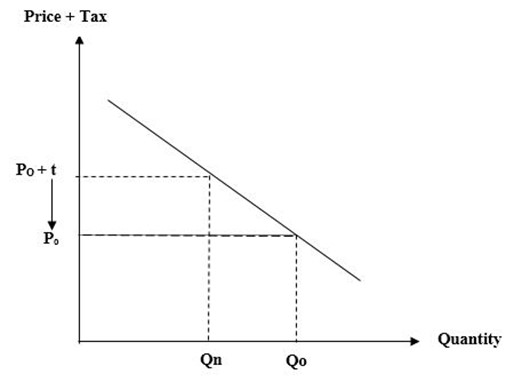
-
When the demand is perfectly inelastic.
Perfectly inelastic demand refers to the elasticity in which price changes do not change the quantity demanded. This is the demand of necessary goods which do not have substitute. In case of such goods an introduction of tax would lead t an increase in price and the burden of the tax is shifted to the buyer.
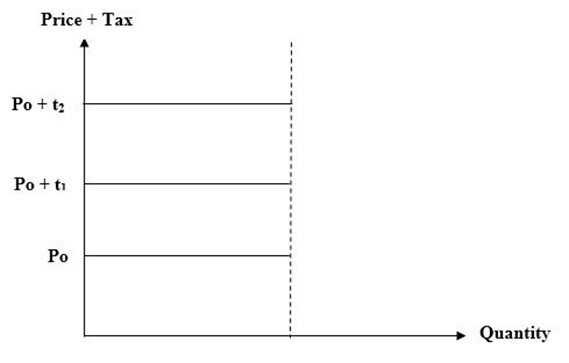
-
When the demand is perfectly elastic.
Perfectly elastic refers to elasticity in which the price remains constant with changes in quantity. The whole burden of the tax is paid by the supplier.
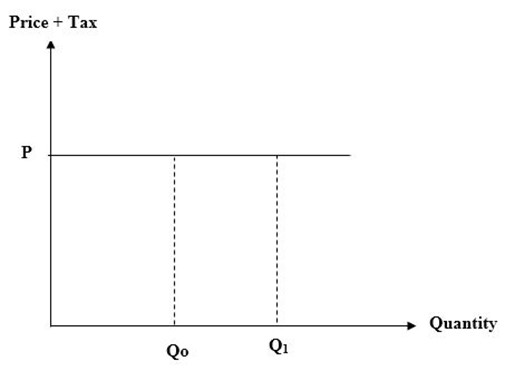
-
When the demand is inelastic
The elasticity of demand of commodity is said to be inelastic when a big change in price leads to a small change in quantity demand. In this case the burden of tax falls to the buyer (consumer)
THERE ARE FACTORS THAT MAY DETERMINE THE SHIFTING OF THE INCIDENCE.
-
The market power of the buyers and sellers.
For a case of monopoly the whole burden is shifted to the buyer through price discrimination while under perfect competition it taken by supplier.
-
The tax base
If the tax base is narrow its difficult to shift the tax burden i.e. if few commodities are taxed and a tax is introduced on other commodities the tax payer would substitute those tax commodities with untaxed commodities and vice versa.
WHY PAYING TAX. (Positive effect of tax)
- To increase government revenue
- To control harmful goods
- To reduce the gap between the rich and the poor
- To enable the government to provide public services
- To control importation of goods and hence correct the balance of payments
- To protect domestic and infant industries
- To control allocation of resources
- Stabilizing the economy.
edu.uptymez.com
NEGATIVE EFFECTS OF TAXATION.
- It disnglish-swahili/courage” target=”_blank”>courages savings
- It disnglish-swahili/courage” target=”_blank”>courages hard working
- It disnglish-swahili/courage” target=”_blank”>courages investment
- It can lead to illegal activities
- It may cause inflation
- It may cause political and social stability in case the revenue is not spent property.
edu.uptymez.com
TAXABLE CAPACITY.
- Refers to the ability of a nation to obtain revenue from tax payers necessary for its expenditure.
- It is the ability of the tax payer to pay the taxes imported on him
-
Refers to the limits of a country capacity to accept and absorb taxation.
THE FOLLOWING ARE FACTORS AFFECTING TAXABLE CAPACITY.
edu.uptymez.com
- The real wealth of a country i.e. resources
- The size of population. The higher the population the higher taxable capacity this depends with the fraction of population engaged in economic activity
- The level of economic development of the country
- The possibility of tax evasion and corruption
- The level of income when is low the lower the taxable capacity
- The attitude of the tax payers in the payment of taxes
- Income nglish-swahili/distribution” target=”_blank”>distribution in the country
- Level of inflation.
edu.uptymez.com
Qn. Discuss why the taxable capacity is low in less developed country
Qn. Discuss the measure of the country can adopt to widen tax base and increase taxable capacity.